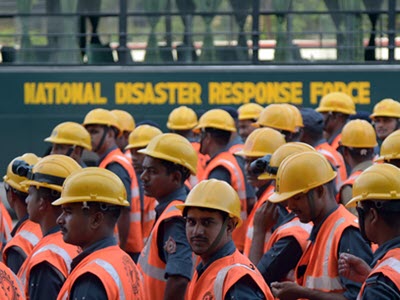Disaster Management
Beyond Existing Frameworks in South Asia
As part of NBR’s project to create a framework for disaster management cooperation in South Asia, Thomas Lutken spoke with Alistair D. B. Cook, a disaster management expert and senior fellow in the Centre for Non-Traditional Security Studies at RSIS in Singapore. Dr. Cook examines the prospects for disaster governance in existing regional initiatives, and argues for the inclusion of smaller yet important stakeholders into the disaster management process.
Disasters affect every aspect of society, from international regions to local towns. Is there a level (international, national, state, city) that is most critical for disaster management? Could improvements be made in cooperation between these levels?
The focus of disaster management is overwhelmingly on capital cities and metropolitan areas, which is where national policy is made and international plans are agreed on. However, the implications and implementation of policies outside these areas is equally important. We need to be more comprehensive in how we mitigate, prepare for, respond to, and recover from disasters. There needs to be a more systemic appraisal of how policies in different locations interact. Policy initiatives in one area can have implications on areas outside that immediate community, with positive and negative spillover effects that need to be considered to ensure progress across the board. This will help avoid succeeding in one place and backsliding on commitments in another.
When dealing with individual countries, size factors into how they will partner with surrounding countries. India, for example, is a large and important country with lots of bilateral activity in disaster relief, but less so in disaster management in South Asia. At present, this work is done on an ad hoc basis and focused on bilateral relations, often in emergency settings, with some important action in disaster preparedness activities like training exercises and information sharing. Often these bilateral interactions are focused on the national level. Although there is some interaction between cities across borders, such as through the World Cities Summit in Singapore, which engages with municipal authorities, countries tend to pay less attention to intercountry, provincial-level cooperation.
You recently conducted a project on disaster governance. Would you give us a short rundown of what that entails?
In my recent study with Christopher Chen, Disaster Governance in the Asia-Pacific: Future Pathways for South and Southeast Asia, I assessed the regional initiatives in South Asia and the prospects for interregional cooperation with Southeast Asia. These initiatives included the South Asian Association of Regional Cooperation (SAARC), the Bay of Bengal Initiative for Multi-Sectoral Technical and Economic Cooperation (BIMSTEC), the Indian Ocean Rim Association, and the Association of Southeast Asian Nations (ASEAN) Defence Ministers’ Meeting-Plus (ADMM-Plus). India is a member of all these initiatives, which highlights its significant capacity to participate in multiple forums and offers one way to illustrate its dominance in South Asia and the wider Asia-Pacific.
The Asia-Pacific is the region most affected by natural hazards globally. So as a starting point, there is the prospect for working together on disasters to not only build resilience but also ensure a sustainable and prosperous region. Disaster management is often seen as low-hanging fruit or a less politically sensitive avenue for cooperation. This has spurred initiatives in all the forums I mentioned. The difficulty is that these are often sector specific and not well coordinated between different sectors.
There is recognition that a more “whole of society” approach is necessary, but substantive progress toward this goal has not been realized. At present, the key developments have been made in the areas of training and information sharing, and less attention and cooperation are focused on integrating strategic planning or reducing barriers to cooperation to facilitate greater interoperability between sectors and organizations.
What are the main challenges to disaster management?
The challenges to more effective cooperation on disaster management can be illustrated by examining some of these regional initiatives. BIMSTEC is playing a larger regional role now because the organization offers India an avenue to avoid difficult political topics with Pakistan that have stymied cooperation in SAARC. That said, more substantive engagement has occurred through SAARC with the establishment of the SAARC Disaster Management Centre. BIMSTEC also involves several countries around the Bay of Bengal, which are members of SAARC and ASEAN—Bangladesh, Bhutan, India, Nepal, and Sri Lanka from South Asia and Myanmar and Thailand from Southeast Asia.
ASEAN has advanced cooperation between its member states on disaster management and is now globally recognized for this substantive progress. There has been some limited engagement beyond member states, though interregional cooperation has not seen substantial progress. ASEAN provides opportunities for greater cooperation with South Asia, given that India is a dialogue partner on initiatives such as the ADMM-Plus Experts’ Working Group on Humanitarian Assistance and Disaster Relief, which is co-chaired by India and Indonesia from 2021 to 2024.
Are there key stakeholders who are not represented adequately in discussions of regional disaster management cooperation? If so, who are they, and how can their considerations be better brought into the discussion?
There remains a real challenge between outside responders and affected communities. Oftentimes community efforts as first responders go unrecognized, while the needs of people in the community go unmet and are often supplied with unnecessary relief. The same mistakes tend to be repeated, and there is very limited change underway. If we look at leadership in disaster governance, it is still dominated by large players. We should support the roles of local organizations rather than using them only as service providers. This is most acute in the emergency response phase. There are a number of opportunities to engage local entities such as through the Start Network and the International Federation of the Red Cross and Red Crescent Societies.
Related to the role of local entities, local leadership is found both within and outside government. In a region with decreasing levels of trust in national leadership, it is important to understand where leadership is trusted by affected communities. This can be found in local employers, trade unions, and community groups, to name a few examples. Because leadership is found in different sections of society, we must recognize the dynamics within a particular environment. There has been a focus on municipal authorities and mayoral leadership to invest in resilient cities, and this is an avenue that has momentum. But this approach needs to be connected to other areas of a country or region.
Another avenue is to facilitate multistakeholder engagement in disaster governance, including local organizations, NGOs, civilian agencies, militaries, the private sector, and the academic and think-tank communities. It is important to engage the actors participating in the multiple civilian and military forums to better understand their niche capabilities and limitations.
Is there an aspect of disaster management or regional cooperation that you feel is overlooked, or a question that is not asked often enough in these discussions?
There is a focus on new technologies and the potential for these developments to improve disaster governance. These are important supporting elements, but they will never be enough on their own. For example, we are better at recording and predicting natural hazards today. Yet access to scientific forecasts and early-warning systems does not necessarily trigger timely action. So an important question to ask is why timely decision-making is absent when there is more scientific evidence? This is a problem not only at the national level but also at the community level.
Barriers exist that prevent action at the community level and across sectors. For example, this year in Germany, early-warning systems predicted and communicated the impending floods, but authorities were still slow to respond, and local communities remained unaware or unwilling to act in significant numbers. This raises a fundamental question that deserves our immediate attention if we are to improve disaster governance in South Asia and the wider Asia-Pacific region.
Alistair D.B. Cook is Coordinator of the Humanitarian Assistance and Disaster Relief Programme and Senior Fellow in the Centre for Non-Traditional Security Studies at the S. Rajaratnam School of International Studies (RSIS) at Nanyang Technological University in Singapore.
This interview was conducted by Thomas Lutken, a project manager with the Energy and Environmental Affairs group at NBR.



